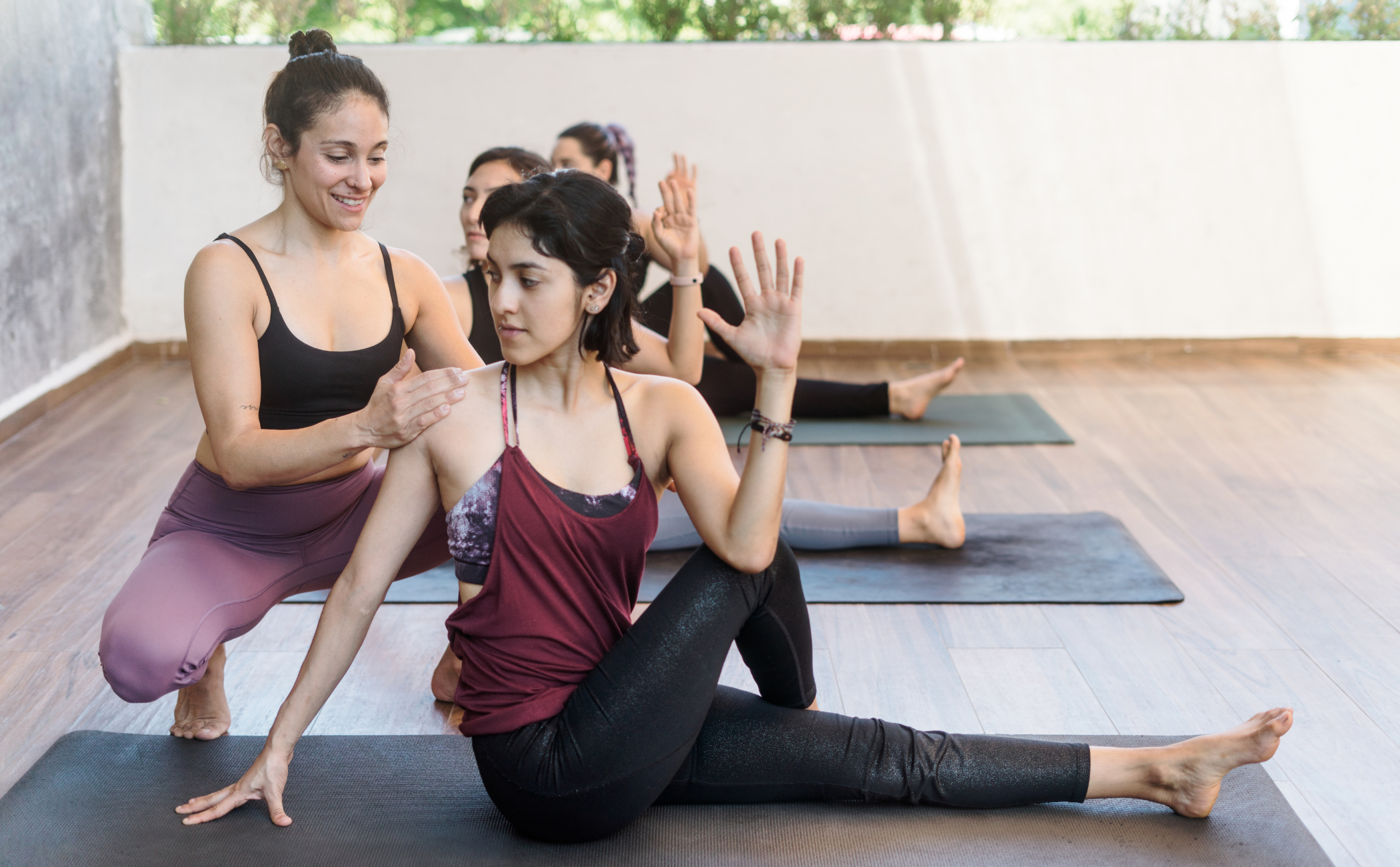Blind football, often referred to as blind soccer, is an adaptive sport that epitomizes resilience, passion, and boundless potential. Designed for visually impaired athletes, this game combines strategy, skill, and teamwork while showcasing the immense capabilities of players who refuse to be defined by limitations. It is an inspiring blend of athleticism and mental fortitude, steadily growing in popularity across the globe.
Blind Football: Where Vision Fades, Passion Rises:

Blind football, also known as blind soccer, is a testament to the resilience of the human spirit. It combines athleticism, teamwork, strategy, and determination, proving that physical limitations are no barrier to living a full and inspiring life. This lesser-known yet extraordinary sport encapsulates the essence of inclusivity and passion.
A Brief History of Blind Football
Blind football has its origins in the late 20th century, born out of informal games played by individuals with visual impairments. Over time, it grew in popularity and was officially formalized as a sport. Its first major recognition came in 2004 when it became a Paralympic event during the Athens Paralympic Games. Since then, blind football has expanded globally, fostering a sense of belonging and empowerment within visually impaired communities.
Various organizations, including the International Blind Sports Federation (IBSA) and FIFA, have contributed to its growth by creating structured competitions and establishing standardized rules. Today, blind football has thriving leagues, regional championships, and a World Cup – all of which underscore its vital role in promoting accessibility in sports.
A Dynamic Sport with Deep Roots:
Blind football traces its beginnings to informal games played by visually impaired individuals seeking community and active engagement. Over time, these games developed into structured competitions, leading to its official debut as part of the Paralympic Games in 2004. Governing bodies such as the International Blind Sports Federation (IBSA) have since expanded the sport, establishing leagues and tournaments to highlight the extraordinary talents of blind athletes worldwide.
This growth has inspired numerous countries to adopt blind football, creating opportunities for participation at local, regional, and international levels. Organizations and clubs continue to invest in blind football training programs, adaptive sports equipment, and coaching strategies to support players.
The Rules of Blind Football:
Blind football is based on traditional five-a-side soccer but is tailored for players with visual impairments. The rules ensure fairness and enhance the gameplay experience. Here’s a breakdown:
- Team Composition: Teams are made up of five players – four field players and one sighted goalkeeper. Field players are classified as B1 athletes (completely blind or with very limited vision), while the goalkeeper has no visual impairment.
- The Ball: The ball contains small noise-making devices like bells or rattles, allowing players to locate it through sound.
- Pitch and Equipment: The pitch is smaller than a standard soccer field, and boundary boards are used along the sidelines to help contain play and provide spatial orientation.
- Communication: Players often use the term “voy” (Spanish for “I go”), notifying teammates and opponents of their position to avoid collisions. Coaches and goalkeepers also provide directional guidance.
- Duration of Play: Matches consist of two 20-minute halves with a 10-minute halftime interval.
- Penalties: Excessive noise, intentional fouls, and other rule violations lead to free kicks or penalties, maintaining competitive fairness.
The rules are carefully designed to prioritize both safety and inclusiveness while emphasizing skill and strategy over brute force.
Training Strategies to Raise Performance:
Blind football training is a specialized field requiring adaptive methods tailored to the unique needs of visually impaired athletes. Coaches and trainers employ various techniques, focusing on physical fitness for blind athletes while enhancing sensory awareness, sound-based coordination, and teamwork skills.
Physical Fitness and Strength Training:
Improving physical fitness is a key component in blind football. Strength training exercises help players build muscle, while endurance exercises improve stamina for intense gameplay. Agility training and balance improvement drills enhance movement precision, ensuring athletes can respond swiftly during a match.
Sound-Based Coordination and Awareness:
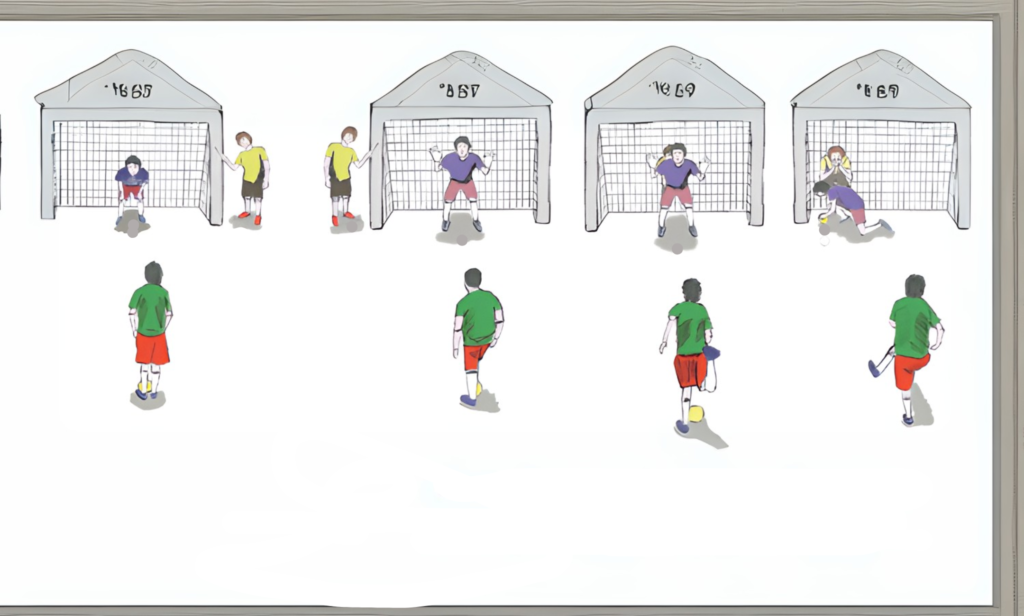
Sound is the backbone of blind football gameplay. Coaches incorporate sound-emitting footballs, allowing players to track the ball’s position. Auditory focus training further sharpens the ability to interpret sound cues during fast-paced matches. Training drills often include players responding to “voy,” a term used to signal player movements on the field.
Goals are paired with sound markers and tactile cues to help players determine positioning. Goalkeepers, although sighted, rely on communication drills to synchronize with their team. Precision drills refine reaction timing, ensuring players can respond to auditory and tactile cues effectively.
Tactile Coaching Methods and Inclusive Strategies:
Blind football training extends beyond physical preparation. Coaches use tactile coaching methods, such as guiding players’ movements directly or using tactile field markers, to teach positioning and game strategy. These inclusive coaching strategies ensure athletes understand gameplay flow and their roles within the team. Role-specific training plans allow players to excel in defensive skills, offensive tactics, or goalkeeping, depending on their strengths.
Confidence Building and Mental Preparation:
Mental strength is pivotal in blind football. Through visualization techniques, athletes mentally rehearse gameplay scenarios, improving their on-field performance. Confidence-building exercises, coupled with stress management techniques, prepare players to handle the pressures of competitions while staying focused.
Benefits of Blind Football:
Participation in blind football offers countless physical, mental, and social benefits. Beyond improving fitness, it positively impacts mental health, skill development, and team dynamics.
Regular fitness routines in blind football promote cardiovascular health, muscle strength, and agility. Players engage in movement drills, sprint exercises, and adapted sports activities, keeping them active and healthy.
Boosted Confidence and Social Inclusion:
Blind football builds self-worth in athletes, empowering them to achieve their goals. Through teamwork and role communication, players form strong bonds, overcoming challenges together. Peer support in sports fosters inclusion, creating lasting friendships and a sense of belonging.
Enhanced Skills and Awareness:
The game strengthens sensory focus, particularly sound awareness and spatial skills. Players develop quick reflexes through reaction practice and improve balance via agility-based workouts.
Advocating for Inclusivity:
Blind football raises awareness about the capabilities of visually impaired individuals, promoting inclusivity in sports. It breaks stereotypes, inspiring others to see disability as an opportunity for resilience rather than a limitation.
Challenges in Blind Football:
While blind football inspires many, it isn’t without its challenges. Athletes and organizations grapple with issues that require consistent effort and innovation.
Limited Access to Resources:
Adapted sports equipment, such as sound-emitting balls and boundary boards, remains costly and inaccessible for many teams. Inclusive workout routines and specialized facilities are also scarce in some regions.
Player Safety and Injury Prevention:
The intensity of blind football requires meticulous adherence to safety protocols to reduce injuries. Physical fitness drills aid in preventing strains, but the risk inherent in collisions during play remains a concern.
Seeking Recognition and Support:
Blind football still lacks the widespread recognition it deserves. More visibility can lead to better funding opportunities, enabling growth in training facilities, equipment procurement, and event organization.
Building Trust and Synchronization:
Coordination between teammates is crucial to blind football. Trust-building exercises and team cues ensure synchronized gameplay, but achieving this harmony requires extensive training and continuous effort. Overcoming Challenges in Blind Football
Despite its many strengths, blind football is not without its challenges. Players, teams, and organizations often face barriers that test their resilience.
- Access to Resources: Equipment such as specialized balls, protective gear, and boundary boards can be costly and hard to source. Additionally, funding for blind football programs is often limited.
- Limited Training Facilities: Not all communities have accessible pitches tailored for blind football, making it difficult for teams to practice regularly and safely.
- Awareness and Recognition: Blind football deserves greater attention from sponsors, spectators, and sporting organizations. Increased visibility can unlock resources and opportunities for players and teams.
- Player Safety: Injuries are a natural part of any sport, but ensuring safety during fast-paced blind football matches requires adherence to rules and proper training.
Overcoming these challenges calls for collaborative efforts from non-profits, governments, and private entities. By investing in the future of blind football, we can help break down barriers and create meaningful opportunities for athletes with visual impairments.
Inspiring Stories of Blind Footballers:
Jeferson Goncalves Mizael Oliveira (Brazil):
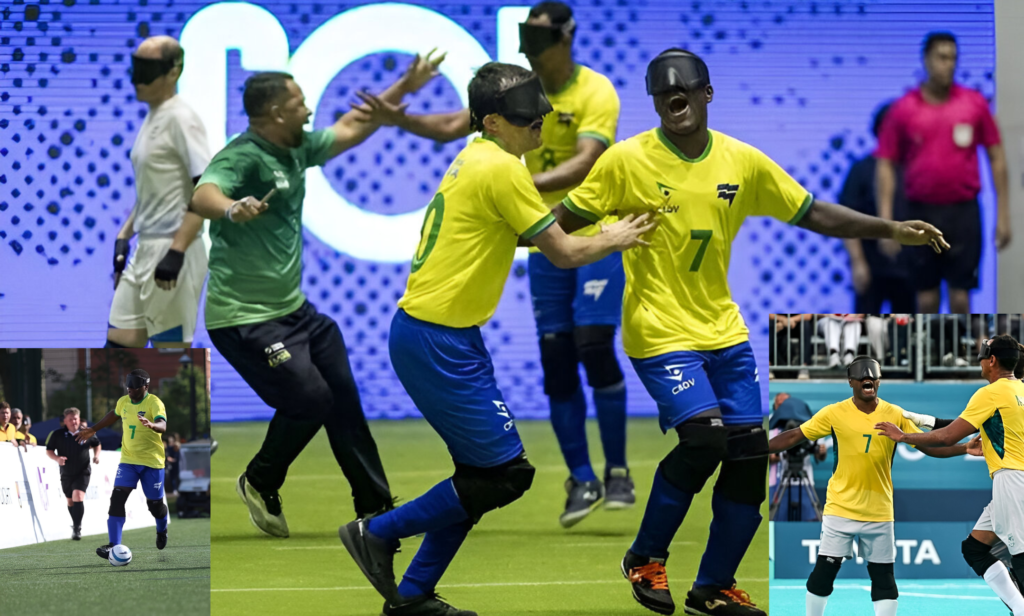
Jeferson Goncalves Mizael Oliveira, widely known as Jefinho or the “Paralympic Pelé,” is a celebrated Brazilian blind football player. Renowned for his exceptional speed and skill, Jefinho has been a key figure in Brazil’s dominance in blind football. He has won four consecutive Paralympic gold medals and is aiming for his fifth, as Brazil seeks to maintain its unbeaten streak in the sport since its introduction to the Paralympic Games in 2004
Austrian Blind Football Team:
The Austrian national team made headlines by developing an inclusive grassroots program aimed at promoting blind football within their country. Their efforts have inspired a new generation of players.
The Indian Blind Football Federation (IBFF):
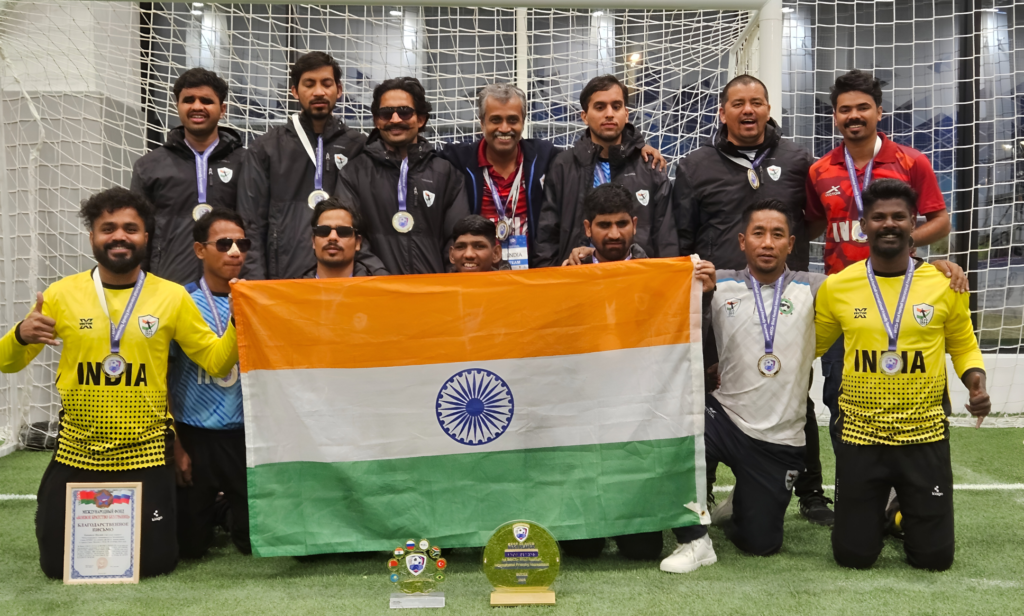
IBFF is a shining example of grassroots development in countries where resources are limited. Their workshops, leagues, and outreach programs connect hundreds of visually impaired individuals with the opportunity to play.
(IBFF) have opened doors for budding players, offering holistic training solutions and a platform to showcase their talent.
These stories reinforce the potential of adaptive sports to drive change, challenge perceptions, and expand opportunities for people living with disabilities.
The Role of Advanced Technology
Innovations in technology play a pivotal role in blind football. Wearable tech for blind athletes, such as haptic feedback systems and audio-enhancing devices, enhances gameplay precision. Tactile feedback instruments and sound-based plays could further revolutionize the way players engage with the game.
Additionally, technological advancements in adaptive sports equipment, like modified field layouts and enhanced sound amplification in footballs, improve training efficiency.
How You Can Support Blind Football:
You don’t need to be a player to contribute to the growth of blind football. Advocacy, volunteering, and financial support go a long way in strengthening its foundations. Here’s how you can help:
- Raise Awareness: Share stories of blind football teams and players on social media, inspiring others to learn about the sport.
- Volunteer: Join local blind football clubs to assist in coaching, logistics, or event organization.
- Donate: Support adaptive sports organizations by funding training programs and equipment purchases.
- Attend Matches: Cheer for your local blind football team, bringing visibility and encouragement to players.
Every contribution matter, creating pathways for visually impaired athletes to pursue their passion and achieve their dreams.
The Path Ahead for Blind Football:
The future of blind football holds immense promise. Ongoing efforts to standardize the sport, introduce it to more regions, and secure funding can help grow its reach. Partnerships with schools, community centers, and disability advocacy groups could also create new pathways for aspiring players.
Technology is another exciting frontier for blind football. Advances in wearable tech and smart gear may enhance gameplay and improve player safety in the coming years. Simultaneously, mainstream sporting events could feature blind football as a showcase sport, lending it greater visibility and credibility.
Ultimately, the path forward hinges on creating an inclusive society that values every individual’s potential, regardless of their abilities.
Blind Football’s Future:
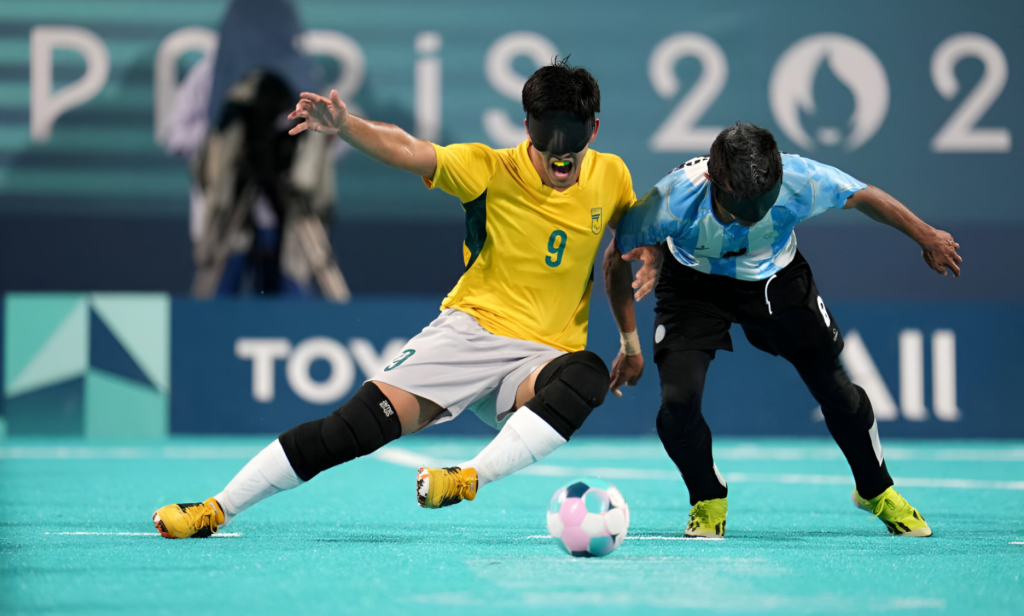
The potential of blind football shines brighter with every passing year. Continued investment in inclusive tactics, adaptive drills, and advanced training techniques will raise the sport to new heights. Collaboration between disability rights groups, sports organizations, and funding bodies can expand access and opportunities globally.
As blind football continues to inspire players and spectators alike, it serves as a powerful reminder of what can be achieved when determination meets opportunity.
Frequently Asked Questions:
Who can play Blind Football?
Individuals with visual impairments ranging from partial sight to complete blindness can participate. Teams are inclusive, often welcoming players of all genders and skill levels.
What distinguishes Blind Football from regular football?
Blind Football uses a smaller playing field with boundary boards, a sound-emitting ball, and blindfolds for all outfield players to ensure fair competition. Communication between players and guides, as well as the auditory aspect, plays a central role in gameplay.
How did Blind Football start?
Blind Football grew from informal games played by people with visual impairments. It was later formalized, debuting as a Paralympic event in 2004, with governing bodies like the IBSA and FIFA supporting its growth.
What are the key rules of Blind Football?
- Teams consist of four blind outfield players and one sighted goalkeeper.
- Players must call “Voy!” (“I’m going”) to indicate their position and avoid collisions.
- The ball contains rattles to help players locate it through sound.
- Coaches and guides provide verbal directions.
- Games last 40 minutes (two 20-minute halves).
What equipment is used in Blind Football?
The game uses a ball with bells or rattles, blindfolds for outfield players, boundary boards, and standard football gear like cleats and protective pads.
What are the benefits of playing Blind Football?
Blind Football enhances physical fitness, boosts mental health, improves skills like spatial awareness, and fosters social connections. It also empowers players, increasing their confidence and advocating for inclusivity.
How are players trained for Blind Football?
Training focuses on physical fitness, sound-based coordination, and teamwork. Drills include strength-building exercises, reaction training, and spatial awareness activities. Coaches often use tactile methods to teach strategies and positioning.
What is the “Voy!” rule?
Players must shout “Voy!” when approaching the ball or other players to signal their intent. This rule prevents collisions and improves coordination during the game.
Are there professional Blind Football competitions?
Yes, Blind Football is showcased in tournaments like the Paralympic Games, the IBSA Blind Football World Championships, and regional leagues. Many countries also organize grassroots programs and national leagues.
What challenges does Blind Football face?
Key challenges include limited access to resources, expensive adaptive equipment, lack of awareness, and ensuring player safety during fast-paced games. Expanding access and recognition remain ongoing priorities.
How does technology support Blind Football?
Advanced technology, like sound-enhanced balls, haptic feedback systems, and tactile coaching tools, helps players train and play more effectively. Innovations continue to make the sport more inclusive and engaging.
Can players with partial sight play Blind Football?
Yes, but all outfield players are required to wear blindfolds to level the playing field. This ensures that players compete solely based on their hearing and spatial awareness.
How can I support Blind Football?
You can support the sport by raising awareness, donating to organizations, volunteering at clubs, or attending matches. Spreading the word about its benefits and challenges also helps grow its visibility.
Are there inspiring stories from Blind Football?
Yes! Players like Ricardinho of Brazil, dubbed the “Pelé of Blind Football,” showcase remarkable talent and determination. Organizations like the Indian Blind Football Federation also inspire by creating platforms for visually impaired athletes to thrive.
How does Blind Football promote inclusion?
Blind Football breaks stereotypes, celebrating the abilities of players with visual impairments. It creates opportunities for skill development, builds community, and advocates for accessibility in sports.
What safety measures are in place for players?
Blind Football follows strict rules to minimize collisions and injuries. Players undergo fitness training to prevent strains, and referees enforce guidelines against excessive force.
Are there youth programs for Blind Football?
Yes, many organizations offer youth programs to teach the fundamentals of Blind Football. These programs help young players build confidence while developing necessary skills for the sport.
What role do sighted goalkeepers and guides play?
Sighted goalkeepers help defend the goal and provide verbal instructions to outfield players. Guides behind the goals also assist players in finding their positions and targeting shots accurately.
conclusion:
Blind football is much more than just a sport. It’s a celebration of courage, creativity, and connection. It breaks stereotypes, empowers individuals, and strengthens communities in ways that few activities can. Whether it’s on a dust-laden pitch in a developing country or at a professional-level World Cup event, the passion and energy of blind football remain constant.
Through perseverance and support, blind football will continue to soar to new heights, proving to the world that limitations are simply challenges waiting to be overcome.



